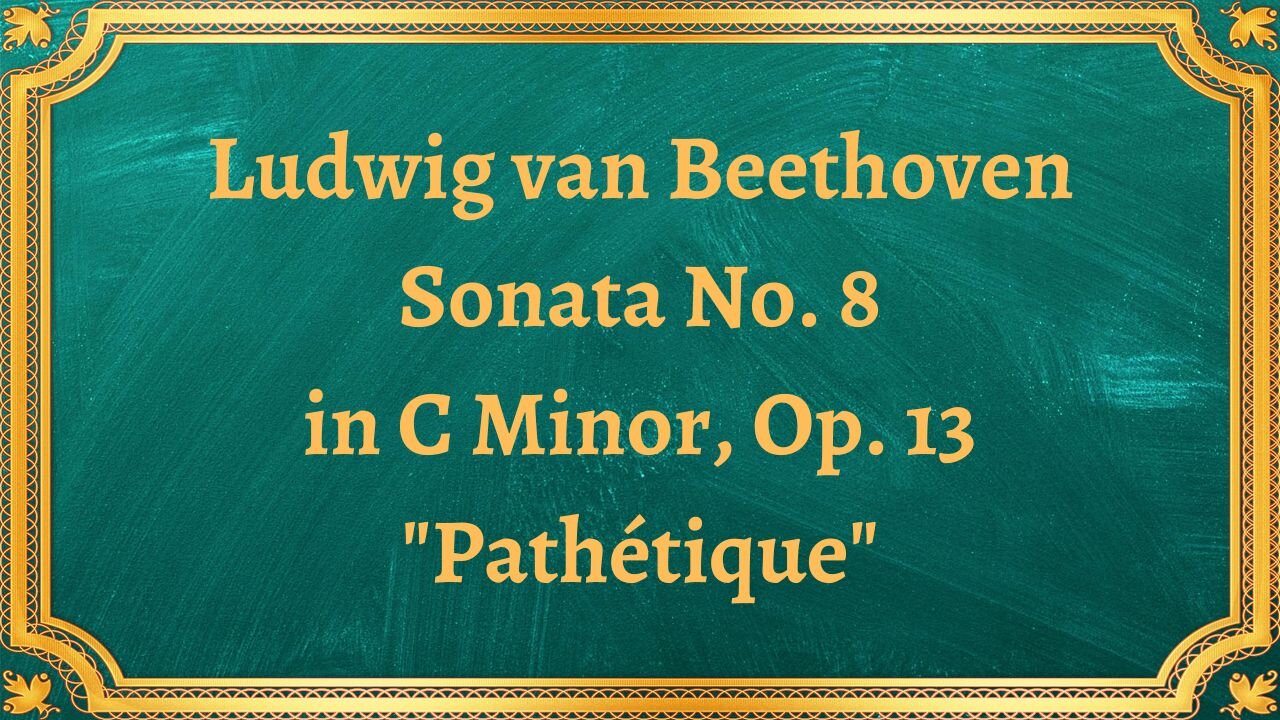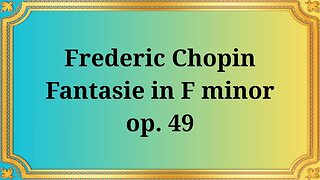Premium Only Content

Ludwig van Beethoven Sonata No. 8 in C Minor, Op. 13 "Pathétique"
#Beethoven #Pathétique #PianoSonata #ClassicalMusic #RomanticEra
Publication date 1948
Rudolf Serkin piano
Ludwig van Beethoven’s Piano Sonata No. 8 in C Minor, Op. 13, commonly known as the “Pathétique” Sonata, is one of his most celebrated compositions. Written in 1798 and published in 1799, this sonata is a prime example of Beethoven's early work and foreshadows the dramatic intensity that would characterize his later compositions.
During the late 18th century, Beethoven was navigating the transition between the Classical and Romantic eras. The “Pathétique” Sonata reflects the emotional depth and complexity that would later define the Romantic movement. At this time, Beethoven was deeply influenced by the works of his predecessors, particularly Wolfgang Amadeus Mozart and Joseph Haydn, but he was already beginning to carve out his unique voice.
The “Pathétique” Sonata consists of three movements:
1. 00:00
The opening movement begins with a slow introduction marked **Grave**, characterized by dramatic pauses and a solemn, almost mournful character. It transitions into the **Allegro di molto e con brio**, where Beethoven unleashes a torrent of energy. The relentless drive of the first theme contrasts sharply with the lyrical second theme, creating a dialogue between varying emotional states. The movement showcases Beethoven's use of dynamics and contrasts, employing sudden shifts between loud and soft passages, which adds to the sense of drama.
2. 08:49
Adagio cantabile
The second movement, Adagio cantabile, offers a calm reprieve from the intensity of the first. Its lyrical theme, often recognized for its beauty, is rich with expressive phrasing. This movement explores the concept of song-like quality in piano music, demonstrating Beethoven’s gift for creating poignant melodies. The variations that occur throughout this movement build emotional depth, enhancing the listener's connection to the music.
3. 14:25
Rondo: Allegro
The final movement, marked Rondo: Allegro, returns to a lively tempo, combining whimsy and exuberance with the contrasting themes characteristic of a rondo form. The interplay of themes creates a festive atmosphere, and Beethoven exploits contrasting dynamics and rapid passages to propel the music forward. The thematic development underscores his innovative approach to structure, allowing for dramatic variations that amplify the overall impact of the movement.
The title “Pathétique” translates to "pathhetic," but its connotation in this context resonates more with the idea of "passionate" or "emotional." The sonata is often interpreted as an exploration of profound human feelings, oscillating between despair and hope. This emotional depth was groundbreaking for its time and laid the groundwork for later Romantic composers.
Beethoven’s ability to encapsulate the human experience through music contributes to the piece's enduring appeal. The “Pathétique” Sonata connects with listeners on a visceral level, allowing them to experience the highs and lows of life through its varied movements.
The “Pathétique” Sonata has profoundly influenced piano music and the development of sonata form. It exemplifies Beethoven’s innovative spirit, pushing the boundaries of emotional expression and structural complexity in instrumental music. Many notable pianists, including Alfred Brendel, Artur Rubinstein, and Leon Fleisher, have interpreted this piece, each bringing their unique style while maintaining the integrity of Beethoven’s vision.
Moreover, the sonata is a staple in concert repertoire, frequently performed in recitals and competitions, underscoring its significance in the classical canon. It frequently appears in popular culture, used in films, television, and even advertisements, affirming its status as one of Beethoven’s most recognizable works.
Ludwig van Beethoven's Piano Sonata No. 8 in C Minor, Op. 13 “Pathétique” is more than just a technical masterpiece; it is a profound expression of the human condition. Its emotional richness, innovative structure, and lyrical melodies ensure that it remains a favorite among musicians and audiences alike. As Beethoven's exploration of complex emotions takes center stage, the “Pathétique” continues to inspire generations, solidifying its place in the pantheon of classical music.
You have the opportunity to support the channel:
https://t.me/rad_siar_al_bot
https://destream.net/live/RadSiarAl/donate
-
 11:13
11:13
Classical music_Music Inspiration
17 days agoFrederic Chopin Fantasy in F minor, Op. 49
362 -
 LIVE
LIVE
StoneMountain64
3 hours agoBattlefield 6 News and Extraction Gaming
75 watching -
 2:13:30
2:13:30
Side Scrollers Podcast
6 hours agoUK Introduces MANDATORY Digital ID + Dallas ICE Shooting BLAMED on Gaming + More | Side Scrollers
85.8K7 -
 1:54:17
1:54:17
The Charlie Kirk Show
4 hours agoCharlie's Last Trip + What's Next + AMA | Erika Kirk, Mikey McCoy | 9.26.2025
272K235 -
 1:02:53
1:02:53
The Quartering
4 hours agoMAGA Kid Kidnapped, Hasan Piker Meltdown, Vivek Fights For Alex Jones & More
129K44 -
 32:49
32:49
Simply Bitcoin
1 day ago $1.83 earnedBitcoin Crucible w/ Alex Stanczyk | EP 1
36.4K -
 1:57:37
1:57:37
Tucker Carlson
3 hours agoCharlie Sheen’s Craziest Hollywood Stories and Why He Refuses to Believe the Official Story of 9/11
60.2K60 -
 1:33:12
1:33:12
Sean Unpaved
4 hours agoRyder Cup Tee-Off, CFB's Week 5 Madness, & the NFL's Win-or-Wilt Week 4
31.9K1 -
 2:07:01
2:07:01
The Culture War with Tim Pool
5 hours agoWho Really Killed Charlie Kirk? Truth Behind Kirk Assassination | The Culture War with Tim Pool
244K232 -
 1:25:28
1:25:28
Lara Logan
15 hours agoTHE REMNANT RISES: Matt Shea & The New Generation of Pastors on Fire for God & Country | Episode 37
42.8K4